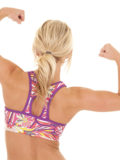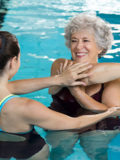
Photo: Deposit Photos
I couldn’t imagine my life without my passions, and neither should those who suffer from mild to severe arthritis, whether it’s rheumatoid, psoriatic, or osteoarthritis.
Something that all active adults have in common is that we can develop arthritis or notice worsening joint pain at any age. Although the idea of physical exertion in the midst of aching joint pain might sound like a recipe for disaster to some, others know it to be their guiding light on the path to painless movement.
From turning keys to leaping off diving boards, we need our bodies for more than just the basics.
Here are eight easy exercises for overcoming the pain and stiffness of arthritis.
1. Walking
Walking is recognized as a go-to exercise for arthritis management because of its low intensity and easy accessibility. Walking eases and strengthens bones and joints at a slow, controlled rate, making it an ideal routine for those looking to recover from pain or stiffness caused by arthritis or injury.
As an added bonus, the health benefits of walking extend beyond the improvement of arthritis symptoms because walking simultaneously reduces the risk of heart disease and controls blood pressure. Walk a familiar path outdoors, or track speed and distance easier by hopping on a treadmill.
2. Water Walking
Take your stroll into the pool with this relaxing, low-intensity exercise. As an alternative to traditional walking, water walking provides nearly all the benefits of ground walking with none of the muscular pressure, suiting those who may be unable to walk for long distances or who simply prefer the water.
This healing exercise relieves and soothes arthritis symptoms, most notably inflammation in regions such as the knees, ankles, and feet. To perform this workout, find a shallow pool, typically 3 to 4 feet deep, and walk from end to end or around the perimeter at a comfortable pace. Gyms and health centers will often have underwater treadmills to make your workout feel as easy as stationary swimming.
3. Cycling
Cycling can prove to be a moderate to strenuous workout for the thighs and quads. Because of its nature as a bone-strengthening routine, cycling is particularly useful for middle-aged people to older adults diagnosed with the common osteoarthritis as a result of being active for many years.
Although cycling may be a demanding exercise for the upper legs, it’s also a light and effective exercise for stiffness felt in rheumatoid arthritis-prone regions such as ankles, feet, wrists, and hands.
Cycling, therefore, offers relief for multiple kinds of arthritis and contributes to balance and coordination in the process. Caution should be taken before attempting more intense cycling ventures, such as mountain or incline biking.
4. Suspension Training
Think of suspension training as standing planks, but instead of putting stress on your elbows and toes by planking on the ground, you’ll be firmly gripping handles that attach to stretching straps and leaning your body down so that you’re at a 45-degree angle to the ground.
Similar to cycling, suspension workouts improve muscular endurance, specifically in the core, shoulders, and back. Due to shorter intervals and the firm tension applied to the hands, wrists, and ankles, this is an ideal workout for people with rheumatoid arthritis who want a shorter workout to alleviate their symptoms.
5. Hand Stretches
Unique to any of the previously discussed arthritis-friendly workouts, hand stretches are not a form of cardio or a way to tone muscles. Rather, they’re solely performed to reduce inflammation flare-up and everyday stiffness in the fingers and wrists caused by rheumatoid arthritis.
The most popular exercises to try barehanded are the knuckle bend, fist clench, fingertip touch, and 360-degree wrist bend. Stress balls are effective at drawing motion from the majority of bones in the hand and strengthen the forearm, as well. For those who suffer from severe RA pain, a recommended hand exercise is a slow and gentle fist clench, performed underwater for optimal relief.
6. Pilates
Pilates is a flexibility workout that can take many forms. From mat-based to equipment-based, the many Pilates positions are known to relieve sharp back pain and stiffness in the neck and shoulders by helping to form spine stability. Similar to walking, Pilates has benefits that serve the body’s all-around well-being, such as improved posture, flexibility, and balance, as well as mental benefits like concentration and relaxation of the mind. For people with arthritis, more specifically, Pilates can reduce stiffness in the morning that may be the result of psoriatic arthritis.
7. Elliptical
Due to the structure of most elliptical machines, it is recommended that anyone who uses an elliptical has built up a fair amount of cardiovascular endurance prior to performing this exercise. Once this level of stamina is reached, the complete muscle workout that the elliptical helps you achieve will not be hindered by the pain and stiffness of arthritis.
This workout is similar to swimming laps because, although the entry-level intensity and speed are relatively advanced compared to those of walking or yoga, there is minimal pressure on any muscles while performing this workout.
8. Light Weightlifting
Lifting light free-weights is important as we age because resistance training fights against bone deterioration. Just as flexibility is important to ease the stiffness of arthritis, the strength of bones and joints is also a factor in arthritis maintenance, overall mobility, and ability to perform everyday tasks that require basic muscle strength.
Some simple free-weight routines to improve these areas are biceps curls, overhead press, and lunges. It’s important to both lift weights within your range of comfort and to avoid working out the same muscle group two days in a row because every part of the body needs rest to properly recover and grow. In addition to treating those with arthritis, light weights can provide physical therapy to people recovering from joint or bone injuries.
Find the time to incorporate any of these light workouts into your weekly routine. Also remember that there are exercises and arthritis treatments that many of us already participate in as hobbies, such as gardening, fishing, golf, and tennis.
The most important piece of advice to keep in mind when performing any exercise is to choose a workout and pace at which you feel comfortable and not susceptible to injury. It is equally important to track the improvement of your arthritis symptoms to know whether the exercise you have chosen is right for your needs.
Dr. David Greuner is the managing director and co-founder of NYC Surgical Associates. Although Dr. Greuner’s surgical training and practice encompasses a broad base of surgical procedures, his area of interest lies specifically 2 main areas; endovascular (no incision) and vascular surgery, particularly endovenous procedures, complex body wall reconstruction and hernia surgery, and procedures after massive weight loss.













